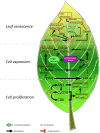The diverse roles of cytokinins in regulating leaf development
- PMID: 34059666
- PMCID: PMC8167137
- DOI: 10.1038/s41438-021-00558-3
The diverse roles of cytokinins in regulating leaf development
Abstract
Leaves provide energy for plants, and consequently for animals, through photosynthesis. Despite their important functions, plant leaf developmental processes and their underlying mechanisms have not been well characterized. Here, we provide a holistic description of leaf developmental processes that is centered on cytokinins and their signaling functions. Cytokinins maintain the growth potential (pluripotency) of shoot apical meristems, which provide stem cells for the generation of leaf primordia during the initial stage of leaf formation; cytokinins and auxins, as well as their interaction, determine the phyllotaxis pattern. The activities of cytokinins in various regions of the leaf, especially at the margins, collectively determine the final leaf morphology (e.g., simple or compound). The area of a leaf is generally determined by the number and size of the cells in the leaf. Cytokinins promote cell division and increase cell expansion during the proliferation and expansion stages of leaf cell development, respectively. During leaf senescence, cytokinins reduce sugar accumulation, increase chlorophyll synthesis, and prolong the leaf photosynthetic period. We also briefly describe the roles of other hormones, including auxin and ethylene, during the whole leaf developmental process. In this study, we review the regulatory roles of cytokinins in various leaf developmental stages, with a focus on cytokinin metabolism and signal transduction processes, in order to shed light on the molecular mechanisms underlying leaf development.
Conflict of interest statement
The authors declare no competing interests.
Figures



Similar articles
-
Enhanced cytokinin degradation in leaf primordia of transgenic Arabidopsis plants reduces leaf size and shoot organ primordia formation.J Plant Physiol. 2011 Aug 15;168(12):1328-34. doi: 10.1016/j.jplph.2011.03.003. Epub 2011 Apr 6. J Plant Physiol. 2011. PMID: 21474200
-
Multifaceted activity of cytokinin in leaf development shapes its size and structure in Arabidopsis.Plant J. 2019 Mar;97(5):805-824. doi: 10.1111/tpj.14285. Plant J. 2019. PMID: 30748050
-
Conditional transgenic expression of the ipt gene indicates a function for cytokinins in paracrine signaling in whole tobacco plants.Plant J. 1997 Aug;12(2):401-15. doi: 10.1046/j.1365-313x.1997.12020401.x. Plant J. 1997. PMID: 9301091
-
Auxin and Cytokinin Interplay during Leaf Morphogenesis and Phyllotaxy.Plants (Basel). 2021 Aug 21;10(8):1732. doi: 10.3390/plants10081732. Plants (Basel). 2021. PMID: 34451776 Free PMC article. Review.
-
The yin-yang of hormones: cytokinin and auxin interactions in plant development.Plant Cell. 2015 Jan;27(1):44-63. doi: 10.1105/tpc.114.133595. Epub 2015 Jan 20. Plant Cell. 2015. PMID: 25604447 Free PMC article. Review.
Cited by
-
Complete genome sequencing and construction of full-length infectious cDNA clone of papaya ringspot virus-HYD isolate and its efficient in planta expression.Front Microbiol. 2023 Nov 30;14:1310236. doi: 10.3389/fmicb.2023.1310236. eCollection 2023. Front Microbiol. 2023. PMID: 38107852 Free PMC article.
-
Transcriptomic and physiological analyses reveal that cytokinin is involved in the compound leaf development of alfalfa.Front Plant Sci. 2025 Jan 29;16:1460205. doi: 10.3389/fpls.2025.1460205. eCollection 2025. Front Plant Sci. 2025. PMID: 39944174 Free PMC article.
-
Cytokinin biosynthesis in cyanobacteria: Insights for crop improvement.Front Genet. 2022 Sep 9;13:933226. doi: 10.3389/fgene.2022.933226. eCollection 2022. Front Genet. 2022. PMID: 36160007 Free PMC article. Review.
-
Overexpression of ZmIPT2 gene delays leaf senescence and improves grain yield in maize.Front Plant Sci. 2022 Jul 19;13:963873. doi: 10.3389/fpls.2022.963873. eCollection 2022. Front Plant Sci. 2022. PMID: 35928712 Free PMC article.
-
Exogenously applied gibberellic acid and benzylamine modulate growth and chemical constituents of dwarf schefflera: a stepwise regression analysis.Sci Rep. 2024 Apr 3;14(1):7896. doi: 10.1038/s41598-024-57985-0. Sci Rep. 2024. PMID: 38570571 Free PMC article.
References
-
- Miller CO, Skoog F, Von Saltza MH, Strong FM. Kinetin, a cell division factor from deoxyribonucleic acid. J. Am. Chem. Soc. 1955;77:1392–1392. doi: 10.1021/ja01610a105. - DOI

